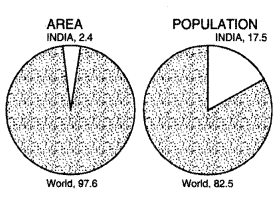India People and Economy.Book – 2
CHAPTER NO. 01
Population: Distribution, Density,
Growth and Composition
Class 12
Geography
Very Short
Answer type questions. (important
Questions)
Q1. What
do you mean by Density of Population?
Ans. Density of population is
expressed as number of person per unit area.
Q2. Which
state has the highest density & lowest density of population according to
the census 2011?
Ans. Highest -Bihar
(1106 km sq.)
Lowest -Arunachal Pradesh (17 km sq.)
Q3. After
how many years is census conducted in India?
Ans. 10 year.
Q4. Name
two states of India where the Hindus are in a minority.
Ans. Lakshadweep &
J&k.
Q5. What
do you mean by Growth rate?
Ans. Growth of
population is the change in the number of people living in a particular area between
two points of time. Its rate is expressed in percentage.
Or
Net change in the size of population
between two points of time.
Q6. What
is the annual growth rate of India according the census 2011?
Ans. 1.64%.
Q7. Which
is the largest minority group of India?
Ans. Muslim.
Q8. Define
Arithmetic Density.
Ans. It is the
ratio between population & the land area, in which the people are living.
Q9. Name
the two dialect families of India.
Ans. Austria, Dravidian.
Q10.
Define the term population distribution?
Ans. The population
distribution is the spatial arrangement of people across the world, i.e. where
do people live.
Q11. What is population doubling time?
Ans.
Population
doubling time is the time taken by any population to double itself at its
current annual growth rate.
Q12. Why India has larger proportion of dependent population?
Ans.
According
to census 2001, the proportion of worker both marginal and main is only 39%
leaving a majority of 61% as non- workers. It indicates an economic status in
which there are a larger proportion of dependent people.
Q13. In which year National Youth Policy is launched. Mention its one
objective?
Ans. National Youth
Policy is launched in 2003.
Objective:- Stresses on an all-round improvement of
the youth.
Q14. What do you understand by ‘Physiological density’?
Ans.
Physiological
density=Total population / net cultivated area.
Q15. Which union territories have higher participation rate?
Ans. Dadra and
Nagar Haveli & Daman and Diu.
Q16. In which categories the working population of India has been
divided?
Ans.
Four
categories are:
1.
Cultivators.
2.
Agricultural labourers.
3.
Household industrial workers.
4.
Other workers.
Q17. Which states have larger percentages of workers?
Ans.
Himachal
Pradesh, Sikkim, Chhattisgarh, etc.
Q18. Which religious community forms the majority in India? What is its
percentage share in total population?
Ans. Hindus are
largest religious community in India with 80.5% out of total population.
Q19. Which religious community is the largest minority in India? What is
its percentage share in total population?
Ans.
Muslims
are the largest minority community in India with 13.5% out of total population.
Q20. Which family has the largest speakers in India?
Ans. Indo-European
(Aryan) with 73%.
Q21. Who are the Main and Marginal workers?
Ans.
A.
Main worker is a person who works for at least 183 days in a year.
B.
Marginal
worker is a person who works for less than 183 days in a year.
Q22 .Which language is spoken in majority and which in minority in India?
Ans. Highest - Hindi
(40.42).
Lowest
-
Kashmiri and Sanskrit (0.01).
Q23. How much work participation rate in India and identify highest and
lowest work participation states?
Ans. Work
participation rate - 39.1%
A)
Highest- Mizoram (52.6 %).
B)
Lowest-
Kerala(32.3%).
Q24. How many workers in household industry? & which states have highest percentage of household
workers?
Ans. Percentage of total household workers- 1.7 %. & Highest: - Percentage of
household workers – Manipur (10.3).
Q25. In
which states development of irrigation has high concentration of population in
India?
Ans. Rajasthan.
Q26. In
which state availability of minerals and energy resources are found in high
concentration of population in India?
Ans. Jharkhand.
Q27.What
is the decadal and annual growth rates of population?
Ans. There are 17
decadal and 1.6% annual growths.
Q28. In
which year the national youth policy of government of India were launched?
Ans. In 2003.
Q29. In India when the female
literacy rate become 100% what will be the impact of possibilities on
population growth rate?
Ans. Probably it will
decrease.
Q30. In
India the plain areas have always concentration of population. Give any one
reason?
Ans. In every year
the rivers send the new soil which is fertile and known as alluvial soil it is
beneficial for agriculture so the large population live in plain areas.
Q33. What
is work participation rate?
Ans. The
participation rate is a measure of the active portion of an economy labour
force. It refers to the number of people who either employed or are actively
looking for Work.
Q34. In
urban areas the populations have high concentration. Why?
Ans. Because in urban
areas the development of urbanization and industrialization are high so the
rural people migrate in urban to attract with them.
Q35. Name
the state having the highest and lowest population growth rate.
Ans. 1.Highest
growth rate:-Nagaland,
2. Lowest growth rate: - Kerala.
Q36. Which
state has the largest population of Buddhists?
Ans. Maharashtra.
Q37. Which
is the largest minority group of India?
Ans. Muslims.
Q38. Mon-Khmer,
Munda branch/group belongs to which language family?
Ans. Austric.
Q39. What
are the reasons for poor female participation in workforce in India?
Ans.1. Low level of
education,
2. Joint family.










0 Comments
Post a Comment
Please do not enter any spam link in the comment box.